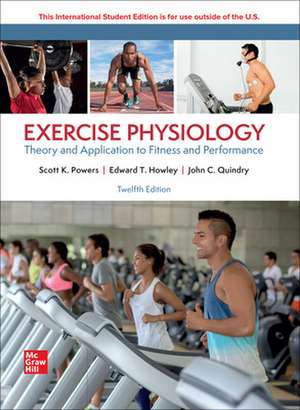Exercise Physiology: Theory and Application for Fitness and Performance ISE
Autor Scott Powers, Edward Howley, John Quindryen Limba Engleză Paperback – 21 mar 2023
Preț: 432.76 lei
Preț vechi: 470.39 lei
-8% Nou
Puncte Express: 649
Preț estimativ în valută:
82.81€ • 89.100$ • 69.48£
82.81€ • 89.100$ • 69.48£
Carte disponibilă
Livrare economică 04-18 aprilie
Livrare express 20-26 martie pentru 58.44 lei
Preluare comenzi: 021 569.72.76
Specificații
ISBN-13: 9781266133909
ISBN-10: 1266133909
Pagini: 738
Dimensiuni: 218 x 277 x 28 mm
Greutate: 1.23 kg
Ediția:12
Editura: McGraw Hill Education
Colecția McGraw-Hill
Locul publicării:United States
ISBN-10: 1266133909
Pagini: 738
Dimensiuni: 218 x 277 x 28 mm
Greutate: 1.23 kg
Ediția:12
Editura: McGraw Hill Education
Colecția McGraw-Hill
Locul publicării:United States
Cuprins
Preface
SECTION 1 Physiology of Exercise
Chapter 0 Introduction to Physiology of Exercise
Chapter 1 Common Measurements in Exercise Physiology
Chapter 2 Control of the Internal Environment
Chapter 3 Bioenergetics
Chapter 4 Exercise Metabolism
Chapter 5 Cell Signaling and the Hormonal Responses to Exercise
Chapter 6 Exercise and the Immune System
Chapter 7 The Nervous System: Structure and Control of Movement
Chapter 8 Skeletal Muscle: Structure and Function
Chapter 9 Circulatory Responses to Exercise
Chapter 10 Respiration during Exercise
Chapter 11 Acid-Base Balance during Exercise
Chapter 12 Temperature Regulation
Chapter 13 The Physiology of Training: Effects of Aerobic and Anaerobic Training
Chapter 14 The Physiology of Resistance Training
SECTION 2 Physiology of Health and Fitness
Chapter 15 Exercise Is Medicine—Part 1: Prevention of Chronic Diseases
Chapter 16 Exercise is Medicine—Part 2: Therapy for Chronic Diseases and Prevention of Age-related Physiological Dysfunction
Chapter 17 Exercise is Medicine—Part3: Exercise Prescriptions for Health and Fitness
Chapter 18 Nutrition, Body Composition, and Weight Management
SECTION 3 Physiology of Performance
Chapter 19 Factors Affecting Performance
Chapter 20 Training for Performance
Chapter 21 Training for the Female Athlete, Children, Special Populations, and the Masters Athlete
Chapter 22 Nutrition, Body Composition, and Performance
Chapter 23 Exercise and the Environment
Chapter 24 Ergogenic Aids
Appendices
Appendix A: Calculation of Oxygen Uptake and Carbon Dioxide Production
Appendix B: Dietary Reference Intakes: Estimated Energy Requirements
Appendix C: Dietary Reference Intakes: Vitamins
Appendix D: Dietary Reference Intakes: Minerals and Elements
Appendix E: Percent Fat Estimate for Men: Sum of Triceps, Chest, and Subscapula Skinfolds
Appendix F: Percent Fat Estimate for Women: Sum of Triceps, Abdomen, and Suprailium Skinfolds
Appendix G: MET Equivalents for Exercise, Activities of Daily Loving, and Household Chores
Glossary
Index
SECTION 1 Physiology of Exercise
Chapter 0 Introduction to Physiology of Exercise
Chapter 1 Common Measurements in Exercise Physiology
Chapter 2 Control of the Internal Environment
Chapter 3 Bioenergetics
Chapter 4 Exercise Metabolism
Chapter 5 Cell Signaling and the Hormonal Responses to Exercise
Chapter 6 Exercise and the Immune System
Chapter 7 The Nervous System: Structure and Control of Movement
Chapter 8 Skeletal Muscle: Structure and Function
Chapter 9 Circulatory Responses to Exercise
Chapter 10 Respiration during Exercise
Chapter 11 Acid-Base Balance during Exercise
Chapter 12 Temperature Regulation
Chapter 13 The Physiology of Training: Effects of Aerobic and Anaerobic Training
Chapter 14 The Physiology of Resistance Training
SECTION 2 Physiology of Health and Fitness
Chapter 15 Exercise Is Medicine—Part 1: Prevention of Chronic Diseases
Chapter 16 Exercise is Medicine—Part 2: Therapy for Chronic Diseases and Prevention of Age-related Physiological Dysfunction
Chapter 17 Exercise is Medicine—Part3: Exercise Prescriptions for Health and Fitness
Chapter 18 Nutrition, Body Composition, and Weight Management
SECTION 3 Physiology of Performance
Chapter 19 Factors Affecting Performance
Chapter 20 Training for Performance
Chapter 21 Training for the Female Athlete, Children, Special Populations, and the Masters Athlete
Chapter 22 Nutrition, Body Composition, and Performance
Chapter 23 Exercise and the Environment
Chapter 24 Ergogenic Aids
Appendices
Appendix A: Calculation of Oxygen Uptake and Carbon Dioxide Production
Appendix B: Dietary Reference Intakes: Estimated Energy Requirements
Appendix C: Dietary Reference Intakes: Vitamins
Appendix D: Dietary Reference Intakes: Minerals and Elements
Appendix E: Percent Fat Estimate for Men: Sum of Triceps, Chest, and Subscapula Skinfolds
Appendix F: Percent Fat Estimate for Women: Sum of Triceps, Abdomen, and Suprailium Skinfolds
Appendix G: MET Equivalents for Exercise, Activities of Daily Loving, and Household Chores
Glossary
Index
